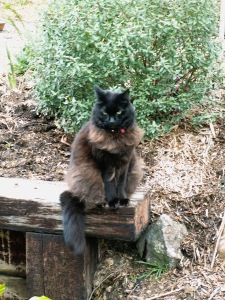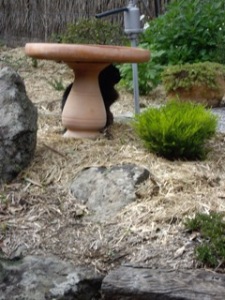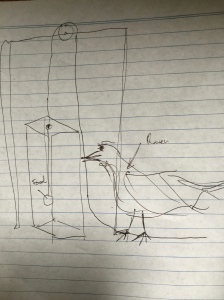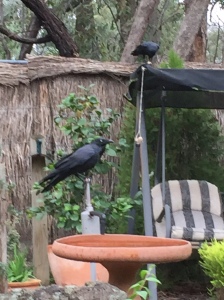 |
| Fighting Crows Minh Waatha Waakarr a linocut by Christine Holroyd |
Throughout time ravens and crows have been given sacred and symbolic meaning, and inspired countless myths and legends. As foretellers of omens they are said to bring both favourable and unfavourable messages. In some European traditions the raven was thought to possess a magical stone, which could help treat various human illnesses. There are also many stories about how the raven became black.
This is a story about a family of Australian Little Ravens (Corvus mellori) who have inhabited a thirty-five metre high spotted eucalyptus in our garden for the last five years.

There is a dreamtime story told by the Wurundjeri people about the Karatgurk women who lived in the Yarra valley and knew the secret of fire. They carried live coals on the ends of their digging sticks to cook food. The raven, Waa Wahn, found some of the cooked food and ate it. He wanted coals to cook his own food but the women wouldn’t share them with him. The raven decided to trick them into giving him some coals. He hid some live snakes and enticed the women to dig there, telling them there was a large termite nest they could harvest. When the women dug, the snakes attacked them and the live coals from the ends of their digging sticks flew up in the air. The crow caught some of the live coals and stored them in a kangaroo skin bag. The women chased him but he flew to the top of a high tree. The eagle hawk saw this and wanted some coals to cook some possum. The crow offered to cook it for him. Soon lots of birds wanted the coals and the crow was scared by their loud demands and flew up into a tree. The birds took the coals causing a bushfire and burning the crow’s feathers black forever.
The raven is one of the most intelligent of birds, a good mimic, agile in flight, but also a trickster. You can visit many YouTube sites and find ordinary people videoing examples of their ingenuity. There are also other sites which scientifically demonstrate their intelligence. The Little Raven occupies the South Eastern part of Australia and has a distinctive call which is distinguishable from other ravens and crows.
Several years ago, when I was home recovering from major back surgery, I had lots of time to look out of our lounge window onto our garden, located next to an Eltham native bush reserve.
A pair of ravens had started to court and I observed them preening each other’s feathers. Ravens usually mate for life, which may be twenty to thirty years.
They began to collect sticks from the ground, pulled strips from the stringy bark tree, and gathered dry grasses and feathers to build a large nest. I even saw one of them with a wire in its beak. They weighed each of their building products in their beaks before flying off. Sometimes I noticed they would weigh a number of sticks before finally choosing the one which best suited their purpose. They are known to be able to use and make tools, even use tools to get other tools, to get food or build their nest. Maybe they bent the wire to make sure their nest stayed in the tree.

Large spotted eucalypt in our garden in Eltham They would fly off over our house with food or building materials so I thought they must live in a neighbouring garden. However one day I happened to be in the garden and saw them fly off over the house and circle back landing at the top of our spotted gum tree. They had successfully tricked me into thinking they lived elsewhere, while demonstrating what they would do to protect their young.
I was then able to locate their large untidy nest right at the top of the tree. I am still amazed it has stayed there all these years through some very wild weather. Maybe that original piece of wire helped secure it. They have also been known to use coat hangers to secure nests!
Once the nest was built there seemed to be a quiet period when the eggs were laid. I think they had two eggs, which hatched. The larger male bird was around the garden more while the female incubated the eggs.

The proud parents would strut along the paths and dig in the garden. If we ever gave them leftovers they would bury them in the garden, carefully looking around to see no-one was watching, later digging it up. They drank from the birdbath and used it to soften food. When they took a bath, they vigorously wet themselves, preened and splashed about. There would be a queue of ravens up on the fence waiting for their turn. Then they would prance around with spiked-up head feathers and prominent long neck feathers as they called to each other.

Enter Cozmo!
We had a large black cat called Cozmo who also believed he owned the garden.

Often he would sit under our birdbath waiting for some unwary bird to land. He had a reputation for catching possums.
I had observed him confronting the ravens on the side fence and he had had to retreat. These large intelligent birds were out of his league.

One day I was roused by a terrible commotion in the garden. Cozmo was sitting provocatively on the path and the ravens were angrily screaming at him. Beside them was a young raven several weeks old who had fallen from the nest and was not yet flying. She was missing some of her throat hackles. I thought her big brother must have pushed her out, but maybe that was a bit of transference on my part from my experience with my older brother.
The raven parents successfully scared off Cozmo and then began to attend to the needs of their chick, hustling her into a more secluded spot while taking it in turns to feed her and her brother, who was safe in the more roomy nest. The research tells us that less than 50% of baby ravens survive their first year. So this chick was at risk.
The raven parents hid their chick every night and then took it in turns to feed and protect her each day. This went on for nearly two weeks until the chick grew her neck feathers and learnt to fly. Because each raven has its own unique voice and talking style and it is able to warn its chick when a cat is close by.
I searched the garden to find the hiding place of the chick but was unsuccessful. I even went out at night with a torch.
The ravens provided their chicks with food, grooming and affection sitting close to them and preening them. I witnessed a lot of feeding of the chick while Cozmo sat at a safe distance. The chicks also played with each other once they learnt to fly.
Ravens often belong in a bigger family because the chicks stay around for up to two years giving them lots of time to learn the skills they need. Consequently when a raven is harmed or killed a number of ravens will mourn the death and warn other ravens of possible danger.
For those who are interested in ravens and crows the documentary below is a fascinating study of their behaviour, intelligence and ability. It provides evidence and interesting stories from all over the world.
After observing this film I wanted to experiment with our ravens who still live in the garden.
I consulted with my son Alex, who kindly drew me a rather sophisticated design with a pulley.

Unfortunately I did not have access to a pulley so on Mother’s Day I obtained some pork fat, constructed a feeding capsule and tied a long length of string to it. Then I hung it from a tree branch in the garden and waited and waited and waited.

Having had no success, the next day I hung another feeding capsule of cooked pork from the swing in the garden and placed bread around it to attract the ravens. We had lots of visits for the homemade bread, one of their favourites, but none of them were interested in my experiment. I thought maybe I needed to change the reward for their endeavours. In the morning I discovered they had taken some of the pork. I loaded the capsules up again and watched and waited.

They soon flew in and spent time walking around and looking at the suspended capsules. Then one raven flew at it knocking it with her claws and the meat fell out. She then walked around picking up the pieces, dunking them in the bird bath and eating them.
This morning I loaded up the empty food capsules in the hope of capturing the ravens on video.
Eureka!
A raven landed on the fence then walked to the top of the swing and slowly pulled up the string, holding it in place with her claw, and took the food out of the capsule. I had captured it all on my phone.
I have learnt a lot more about my raven family from writing this story.
Ravens and crows can recognise humans who have been kind and cruel to them, I hope they remember me as a good friend.

Love this story Janet – and the visuals are beautiful
LikeLike
I’m a bit of a twitcher too, Janet, so I really liked your story. Of course Waa, the crow, and Bunjil, the eagle, are the spiritual ancestors of this area.
LikeLike
Many years ago, when we had show and tell in my class, a child brought in a next that was totally made of wire. Quite thick wire too. It was amazing.
LikeLike
Janet – a fellow bird lover, who knew! They are most amazing creatures aren’t they? My mother has a family of ravens who visit constantly, tapping on her window and calling for her to feed them. Sometimes they just sit and watch her working in the kitchen, from the windowsill of course! They are a delight? I love your experiment – so clever!
LikeLike